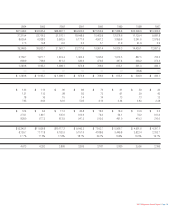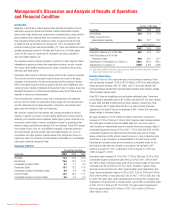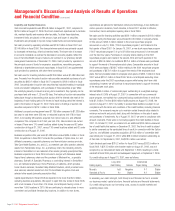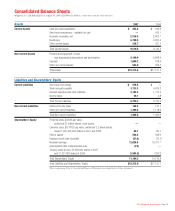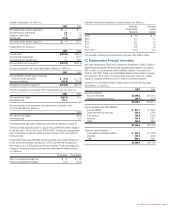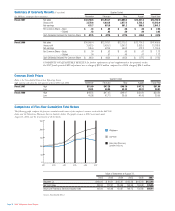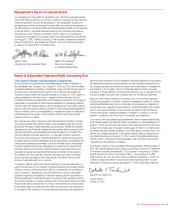Walgreens 2007 Annual Report Download - page 29
Download and view the complete annual report
Please find page 29 of the 2007 Walgreens annual report below. You can navigate through the pages in the report by either clicking on the pages listed below, or by using the keyword search tool below to find specific information within the annual report.
Notes to Consolidated Financial Statements
1. Summary of Major Accounting Policies
Description of Business
The company is principally in the retail drugstore business and its operations are
within one reportable segment. At August 31, 2007, there were 5,997 locations in
48 states and Puerto Rico. Prescription sales were 65.0% of total sales for fiscal
2007 compared to 64.3% in 2006 and 63.7% in 2005.
Basis of Presentation
The consolidated statements include the accounts of the company and its
subsidiaries. All intercompany transactions have been eliminated. The consolidated
financial statements are prepared in accordance with accounting principles
generally accepted in the United States of America and include amounts based
on management’s prudent judgments and estimates. Actual results may differ
from these estimates.
The balance sheet reflects the reclassification of goodwill from other non-current
assets. The cash flow statement contains reclassifications of previously condensed
lines within the operating activity section.
Cash and Cash Equivalents
Cash and cash equivalents include cash on hand and all highly liquid investments
with an original maturity of three months or less. Included in cash and cash equiv-
alents are credit card and debit card receivables from banks, which generally settle
within two business days, of $67.0 million at August 31, 2007, and $54.7 million
at August 31, 2006. The company’s cash management policy provides for controlled
disbursement. As a result, the company had outstanding checks in excess of funds
on deposit at certain banks. These amounts, which were $302.6 million as of
August 31, 2007, and $575.3 million as of August 31, 2006, are included in trade
accounts payable in the accompanying consolidated balance sheets.
Short-Term Investments – Available for Sale
The company’s short-term investments – available for sale are principally auction
rate securities. The company invests in municipal bonds and student obligations
and purchases these securities at par. While the underlying security is issued as a
long-term investment, they typically can be purchased and sold every 7, 28 and 35
days. The trading of auction rate securities takes place through a descending price
auction with the interest rate reset at the beginning of each holding period. At the
end of each holding period the interest is paid to the investor. At August 31, 2007,
there were no holdings of auction rate securities compared to $415.1 million in
fiscal 2006. There were no significant unrealized gains on these securities at
August 31, 2006.
Financial Instruments
The company had $76.9 million and $105.1 million of outstanding letters of
credit at August 31, 2007 and 2006, respectively, which guarantee foreign trade
purchases. Additional outstanding letters of credit of $276.8 million and
$282.2 million at August 31, 2007 and 2006, respectively, guarantee payments
of casualty claims. The casualty claim letters of credit are annually renewable and
will remain in place until the casualty claims are paid in full. Letters of credit of
$12.2 million and $1.7 million were outstanding at August 31, 2007, and August
31, 2006, respectively, to guarantee performance of construction contracts. The
company pays a facility fee to the financing bank to keep these letters of credit
active. The company had real estate development purchase commitments of
$980.4 million and $782.8 million at August 31, 2007 and 2006, respectively.
There were no investments in derivative financial instruments during fiscal 2007
and 2006 except for the embedded derivative contained with the conversion
features of the $28.5 million of convertible debt acquired in the Option Care, Inc.
and affiliated companies acquisition. The value of such derivative is not material
and the debt was retired on September 6, 2007.
Inventories
Inventories are valued on a lower of last-in, first-out (LIFO) cost or market basis.
At August 31, 2007 and 2006, inventories would have been greater by
$968.8 million and $899.5 million, respectively, if they had been valued on a
lower of first-in, first-out (FIFO) cost or market basis. Inventory includes product
cost, inbound freight, warehousing costs and vendor allowances not included
as a reduction of advertising expense.
Cost of Sales
Cost of sales is derived based upon point-of-sale scanning information with an
estimate for shrinkage and is adjusted based on periodic inventories. In addition
to merchandise cost, cost of sales includes warehousing costs, purchasing costs,
freight costs, cash discounts and vendor allowances not included as a reduction
of advertising expense.
Vendor Allowances
Vendor allowances are principally received as a result of purchase levels, sales or
promotion of vendors’ products. Allowances are generally recorded as a reduction
of inventory and are recognized as a reduction of cost of sales when the related
merchandise is sold. Those allowances received for promoting vendors’ products
are offset against advertising expense and result in a reduction of selling, occupancy
and administration expenses to the extent of advertising costs incurred, with the
excess treated as a reduction of inventory costs.
Property and Equipment
Depreciation is provided on a straight-line basis over the estimated useful lives of
owned assets. Leasehold improvements and leased properties under capital leases
are amortized over the estimated physical life of the property or over the term of
the lease, whichever is shorter. Estimated useful lives range from 121
/2to 39 years
for land improvements, buildings and building improvements and 3 to 121
/2years
for equipment. Major repairs, which extend the useful life of an asset, are capitalized
in the property and equipment accounts. Routine maintenance and repairs are
charged against earnings. The majority of the business uses the composite
method of depreciation for equipment; therefore, gains and losses on retirement
or other disposition of such assets are included in earnings only when an
operating location is closed, completely remodeled or impaired. Fully depreciated
property and equipment are removed from the cost and related accumulated
depreciation and amortization accounts. Property and equipment consists of
(In Millions):
2007 2006
Land and land improvements
Owned locations $ 2,011.8 $1,667.4
Distribution centers 102.7 94.2
Other locations 211.9 93.5
Buildings and building improvements
Owned locations 2,244.9 1,824.6
Leased locations (leasehold improvements only) 581.5 537.6
Distribution centers 553.2 483.4
Other locations 269.9 229.0
Equipment
Locations 3,604.2 3,157.7
Distribution centers 879.2 773.3
Other locations 266.0 214.4
Capitalized system development costs 207.9 171.7
Capital lease properties 43.3 40.2
10,976.5 9,287.0
Less: accumulated depreciation and amortization 2,776.6 2,338.1
$ 8,199.9 $6,948.9
2007 Walgreens Annual Report Page 27




